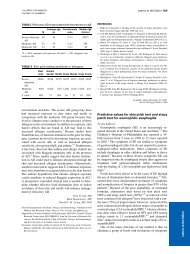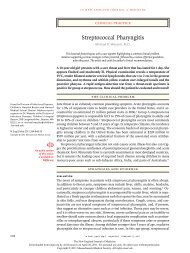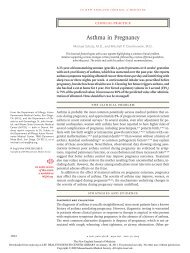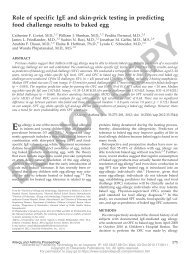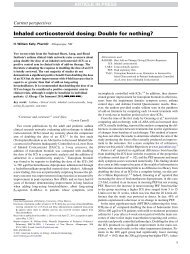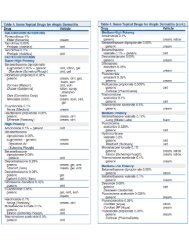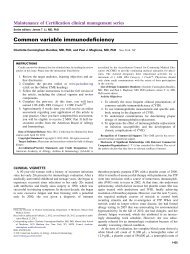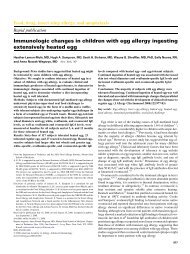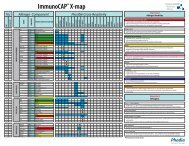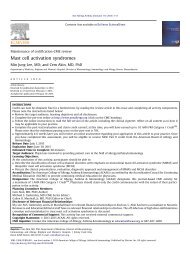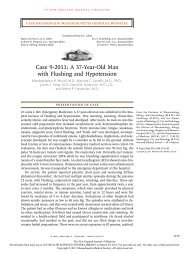Diagnosis and management of hymenoptera venom allergy - AInotes
Diagnosis and management of hymenoptera venom allergy - AInotes
Diagnosis and management of hymenoptera venom allergy - AInotes
- No tags were found...
You also want an ePaper? Increase the reach of your titles
YUMPU automatically turns print PDFs into web optimized ePapers that Google loves.
1204 M. T. Krishna et alTable 1. Description <strong>and</strong> habitat <strong>of</strong> stinging insects in the United KingdomInsect Description Image yearField stings–usual time <strong>of</strong>Wasp (Vespula vulgaris)19 mm long, yellow head with blackstripes, black thorax with yellow sides,yellow abdomen with black b<strong>and</strong>s, blackantennae <strong>and</strong> yellow legs.March–OctoberEuropean Hornet (Vespa crabo)35 mm long, reddish brown head, black <strong>and</strong>brown shaded thorax, yellow <strong>and</strong> blackshaded abdomen.March–OctoberHoney bee (Apis mellifera)12.7–25.3 mm, covered with short densehair, usually golden brown <strong>and</strong> black,abdomen striped.March–October, occasionallyeven in warm winter daysBumble Bee (Bombus pascuorum,Bombus lapidarius, Bombuspratorum, Bombus terrestris,Bombus lucorum, Bombushortorum)19.1–38 mm head to tail, black <strong>and</strong> yellows<strong>of</strong>t body hairs <strong>and</strong> appear fuzzy, <strong>of</strong>ten inb<strong>and</strong>s, some have orange or red in theirbodies, or entirely black.February–October Black bar below the image indicates relative size <strong>of</strong> the <strong>hymenoptera</strong> species, the dashed line indicates variation within the species (images obtainedwith permission from http://www.naturalvisions.co.uk (wasp image) <strong>and</strong> from http://www.naturephoto-cz.eu (bee, bumble bee <strong>and</strong> hornet images).There is substantial IgE <strong>and</strong> clinical cross-reactivitybetween wasps <strong>and</strong> hornets (subfamily vespinae) [28–30].There is only limited [31] specific IgE cross-reactivitybetween wasp <strong>and</strong> bee <strong>venom</strong>s due to the hyaluronidasecomponent but this is rarely clinically relevant [32–35].Paper wasps are not currently found in the United Kingdombut occur in other parts <strong>of</strong> Europe. There is limitedIgE cross-reactivity between wasp/hornet <strong>and</strong> paper wasp<strong>venom</strong> [31]. Venoms from bumble bee <strong>and</strong> honey bee arehighly cross-reactive clinically which is consistent withthe degree <strong>of</strong> structural homology found in the enzymes[36, 37]. About 75% <strong>of</strong> sera from patients allergic to honeybee <strong>venom</strong> react to in vitro tests with bumble bee <strong>venom</strong>,<strong>and</strong> 85% <strong>of</strong> sera from patients with a history <strong>of</strong> <strong>allergy</strong> tobumble bee stings demonstrate positive tests to honey bee<strong>venom</strong> [37]. However, bumble bee <strong>venom</strong> contains severalc 2011 Blackwell Publishing Ltd, Clinical & Experimental Allergy, 41 : 1201–1220
BSACI <strong>venom</strong> <strong>allergy</strong> guidelines 1205Table 2. Scientific <strong>and</strong> common names <strong>of</strong> <strong>hymenoptera</strong> worldwide (reproduced <strong>and</strong> adapted with permission from Fern<strong>and</strong>ez [27])Scientific UK USA Danish Dutch French German Italian SpanishApis Mellifera Honey bee Honey bee Honningbi Bij Abeille Biene Ape AbejaBombus Bumble bee Bumble bee Havehumle/Humlebi Hommel Vrai Bourdon Hummel Bombo AbejorroVespula Wasp Yellow Jacket Hveps/Gedehams Wesp Guêpe Wespe Vespa Avispa(Giallone)Dolicho-vespula Wasp Hornet or aerial Hveps/Gedehams Wesp Faux Frelons Wespe Calabrone AvispaYellow JacketamericanoVespa Hornet European Hornet Stor gedehams Horzel Vrais Frelons Hornisse Calabrone AvispónEuropeoPolistesPaper Wasp Paper hveps Veldwesp Guêpe poliste Feld-Wespe Polistes AvispaPapelera Not found in the United Kingdom <strong>and</strong> the Netherl<strong>and</strong>s.Table 3. Hymenoptera Venom Allergens relevant to UK practiceVenomComponent (in bold are majorallergens)Honey bee (Apis mellifera) Phospholipase A2 (PLA2)HyaluronidaseAcid PhosphataseMellitinAllergen C (dipeptidylpeptidase)Serine Protease10 kDa proteinBumble bee (Bombus spp.) Phospholipase A2HyaluronidaseAcid PhosphataseProtease (<strong>of</strong> tryptic amidase specificity)Fraction-4Wasp (Vespula spp. <strong>and</strong> Antigen 5Dolichovespula spp.) Phospholipase A1HyaluronidaseHornet (Vespa spp.) Antigen 5Phospholipase A1Hyaluronidase Called yellow jacket in the United States. Wasp species encountered inUnited Kingdom is Vespula vulgaris.minor allergens that are not found in honey bees [37](Table 3).Thirty percent <strong>of</strong> patients with a clinical history <strong>of</strong><strong>hymenoptera</strong> <strong>venom</strong> <strong>allergy</strong> are positive to both bee <strong>and</strong>wasp allergens on in vitro testing for serum-specific IgEbut clinical double-reactivity to apidae <strong>and</strong> vespidae israre [9, 38]. Double positivity seen in diagnostic tests,particularly with in vitro methods, is due to 50% sequenceidentity <strong>of</strong> hyaluronidases <strong>and</strong> cross-reactive carbohydrateallergenic determinants between <strong>venom</strong>s (hyaluronidases,acid phosphatase <strong>and</strong> phospholipase A2) <strong>and</strong>plants (e.g. pollens). The double positivity seen with invitro methods can <strong>of</strong>ten be discriminated by skin tests [38]where positive results are more likely to be seen only tothe <strong>venom</strong> to which the individual is truly sensitized.Intradermal skin tests rarely show double positives (33).Another approach is to use RAST inhibition tests with<strong>venom</strong>s <strong>and</strong> cross-reactive carbohydrate determinants[35, 39, 40], but in the United Kingdom this remains aresearch tool. A recent report has highlighted the utility <strong>of</strong>estimation <strong>of</strong> IgE to species-specific recombinant majorallergens including Api m1 (bee <strong>venom</strong>) <strong>and</strong> Ves v5(vespula) for identifying true sensitization when dualpositivity is present [41]. Results from all diagnostic testsmust be interpreted in the context <strong>of</strong> the clinical historyin order to choose the appropriate <strong>venom</strong> for immunotherapy.Allergic reactions to <strong>hymenoptera</strong> <strong>venom</strong>Minor local reactions to insect stings are normal <strong>and</strong> donot warrant <strong>allergy</strong> testing. However, some local reactionscan be large <strong>and</strong> troublesome <strong>and</strong> are characterized byoedema, erythema or pruritis. An area <strong>of</strong> induration with adiameter <strong>of</strong> 410 cm <strong>and</strong> which peaks between 24 <strong>and</strong> 48 h<strong>and</strong> then subsides is referred to as a LLR [42]. Theliterature relating to LLR is poor <strong>and</strong> fragmentary. It isestimated that the risk <strong>of</strong> developing a SR after a LLR isrelatively low (5–15%) <strong>and</strong> this observation is consistentin adults <strong>and</strong> children [16, 19, 43]. Another study hassuggested that a LLR does not significantly increase therisk <strong>of</strong> a SR to future stings [8].SRs are usually <strong>of</strong> rapid onset within minutes <strong>of</strong> thesting. They vary in severity, from minor urticaria throughto loss <strong>of</strong> consciousness (Table 5). Hypotension is the keysevere feature, but there is also a high incidence <strong>of</strong>respiratory <strong>and</strong> cutaneous involvement. Patients withsevere SRs <strong>of</strong>ten suffer a feeling <strong>of</strong> impending doom.In some patients, there is sudden hypotension, (collapse<strong>and</strong> loss <strong>of</strong> consciousness) with no other features. Conjunctivitismay occur but is <strong>of</strong>ten not noticed; rhinitisis uncommon. Rare manifestations are seizures <strong>and</strong> incontinence.Less commonly patients develop a biphasic anaphylacticresponse. Fatal reactions are rare but almost certainlyunder-recognized. Where data was ascertained, insect stingsc 2011 Blackwell Publishing Ltd, Clinical & Experimental Allergy, 41 : 1201–1220
BSACI <strong>venom</strong> <strong>allergy</strong> guidelines 1207another generalized reaction), the patient’s immune responseat the time <strong>of</strong> the sting (this will change over time),the dose <strong>of</strong> <strong>venom</strong> injected, <strong>and</strong> the site <strong>of</strong> the sting.Clinical featuresWhen taking a medical history it is helpful to classify theseverity <strong>of</strong> each sting as local or systemic <strong>and</strong> any SR asmild, moderate or severe as this influences <strong>management</strong>.Table 5 shows a classification <strong>of</strong> systemic allergic reactionsto stings.Venom <strong>allergy</strong> in childrenHymenoptera stings in children occur usually duringoutdoor play. Children with <strong>venom</strong> <strong>allergy</strong> are usuallynon-atopic <strong>and</strong> those with food <strong>allergy</strong> are not atincreased risk [48]. LLR are common in children <strong>and</strong> n<strong>of</strong>urther investigation is necessary.The prevalence <strong>of</strong> SRs to <strong>hymenoptera</strong> stings in thepediatric population is unknown [48]. Most children withsystemic allergic reactions to insect stings have skinmanifestations only. A small percentage <strong>of</strong> children willhave more severe sting-induced systemic allergic reactionsbut fatal reactions are rare [12, 49, 50]. The severity<strong>of</strong> the initial reaction is <strong>of</strong> prognostic value. In childrenwith a history <strong>of</strong> a mild SR, there was no SR to 91% <strong>of</strong>subsequent stings. 32% <strong>of</strong> children who have moderate–severe SRs to insect stings have reactions <strong>of</strong> similarseverity following re-stings [51]. When subsequent SRshave occurred in children almost all were less severe <strong>and</strong>none more severe [43]. The risk <strong>of</strong> systemic allergicreactions to subsequent stings declines slowly with timealthough the risk <strong>of</strong> a SR can persist in up to 20% on longtermfollow-up [51, 52].Non-allergic manifestationsRare toxic reactions can occur with multiple simultaneousstings manifesting as delayed haemolysis, nephropathy,coagulopathy <strong>and</strong> neurological symptoms. There are isolatedcase reports <strong>of</strong> unusual reactions attributed to <strong>hymenoptera</strong>insect stings [53–61]. There is no evidence that these are IgEmediatedalthough the underlying mechanisms are notknown. A multi-disciplinary approach with input fromother specialists may be required <strong>and</strong> treatment is usuallyconservative. Reports <strong>of</strong> unusual reactions to <strong>hymenoptera</strong>insect stings are summarized in Table 6. Immunotherapyis not indicated <strong>and</strong> should not be attempted.Factors influencing the risk <strong>of</strong> a future reactionSensitization per se <strong>and</strong> levels <strong>of</strong> <strong>venom</strong>-specific IgE donot predict the likelihood <strong>and</strong> severity <strong>of</strong> a future reaction[2]. As with field stings, the negative predictive value <strong>of</strong> aTable 6. Unusual non-allergic manifestations attributed to <strong>hymenoptera</strong>insect stings [53–61]TypeCNSHaematologicalMuscleRenalRespiratoryEyeToxic (frommultiplestings usually450)ManifestationsCNS, central nervous system.Acute disseminated encephalopathyGuillain Barré SyndromeMyasthenia GravisPeripheral NeuritisThrombocytopenia PurpuraHenoch–Schonlein PurpuraHaemolysisCoagulation defectsRhabdomyolysis with acute renal failureAcute Renal Failure due to interstitial nephritis/tubulardamageNephrotic syndromeAlveolar HaemorrhageDirect sting causing corneal damage <strong>and</strong> cataractRenal failure, rhabdomyolysis, cerebral oedema,haemolysis, clotting disorders, sting site necrosis.sting challenge in assessing clinical reactivity is poor <strong>and</strong>therefore not recommended in routine clinical practice[62]. An elevated baseline tryptase increases the risk <strong>and</strong>severity <strong>of</strong> a SR. Clinical factors must also be consideredfor example the patient’s occupation influencing the likelihood<strong>of</strong> further stings, the interval from the last sting<strong>and</strong> the severity <strong>of</strong> the initial SR.Investigations for <strong>hymenoptera</strong> <strong>venom</strong> <strong>allergy</strong>All patients with a history <strong>of</strong> SRs should be referred to an<strong>allergy</strong> specialist for further investigation. A detailedhistory is key to accurate diagnosis. A clear account <strong>of</strong>the symptoms <strong>and</strong> progression <strong>of</strong> the allergic reactionfollowing the sting should be obtained. Details <strong>of</strong> thetiming <strong>of</strong> previous stings <strong>and</strong> subsequent allergic reactionsare important. Clues to enable identification <strong>of</strong> theculprit insect should be sought, e.g. if there was a knownwasp’s nest or whether the insect left the stinger behind(bees usually leave a barbed stinger behind). The treatmentprovided including scrutiny <strong>of</strong> emergency roomrecords may aid the decision on whether to <strong>of</strong>fer immunotherapy.Demonstration <strong>of</strong> <strong>venom</strong>-specific immunoglobulin Ei. Skin testing: Skin testing is the gold st<strong>and</strong>ard investigationfor <strong>hymenoptera</strong> <strong>venom</strong> <strong>allergy</strong> because a resultis immediately available during the initial consultation<strong>and</strong> provides greater discrimination between bee <strong>and</strong>wasp sensitization than serum-specific IgE to whole<strong>venom</strong>. Skin tests are also more <strong>of</strong>ten positive thanserum-specific IgE <strong>and</strong> correlate better with history.c 2011 Blackwell Publishing Ltd, Clinical & Experimental Allergy, 41 : 1201–1220
1210 M. T. Krishna et alBox 1.Indications for VITYes Sometimes Not usually NoSystemic reaction withhypotensionlaryngealoedemaasthmaMust have positive <strong>venom</strong>specific IgEMild asthma, moderate angio-oedema,abdominal pain, vomiting, diarrhoea, mildhypotensive symptoms (light headedness,dizziness)In those at high risk <strong>of</strong> further stings, e.g.beekeeper/proximity to bees, or occupationalexposure, e.g. fruit farmers, gardeners, etc.Other factors, e.g. proximity to medical help,patient preference, effect on quality <strong>of</strong> life.Cutaneous systemic reaction, e.g.cutaneous: urticaria1/ mildangio-oedemaLocal reactionToxic reactionAny systemicreaction,independent <strong>of</strong>severity, ifnegative specificIgE Co-morbid conditions including asthma or other respiratory disease, cardiac conditions, raised baseline plasma tryptase/mastocytosis constitute ‘riskfactors’ <strong>and</strong> should be carefully considered before making a decision for VIT.Box 2.Precautions with VITVIT is contraindicated in patients with brittle asthma or chronic severe asthma, although may be cautiously initiated in patients with moderately severeasthma after establishing good control.VIT should not be initiated in patients with psychiatric disorders that will interfere with compliance.The effects <strong>of</strong> VIT in patients with disorders <strong>of</strong> the immune system such as active systemic autoimmunity, immunodeficiency <strong>and</strong> lymphoidmalignancies are not known <strong>and</strong> therefore the decision to <strong>of</strong>fer treatment should be based on an individual ‘risk-benefit’ analysis.VIT should not be initiated in pregnancy but may be continued during pregnancy in patients on maintenance therapy who have tolerated VIT well.However the patient should be informed <strong>of</strong> the risk <strong>of</strong> anaphylaxis even during maintenance treatment that could potentially affect the foetus.In patients on ACE inhibitors <strong>and</strong> b-blockers (see following sections)Tricyclic antidepressants should ideally be withdrawn before commencement <strong>of</strong> VIT <strong>and</strong> replaced if appropriate by selective serotonin reuptakeinhibitors (SSRI) because <strong>of</strong> potential drug interaction (arrhythmia <strong>and</strong> hypertension) with adrenaline.reactions with subsequent stings. Symptoms <strong>and</strong> signsinclude: bronchospasm <strong>and</strong>/or upper-airway oedema<strong>and</strong>/or hypotension [51]. However, VIT is not indicated forthe majority <strong>of</strong> children who have less severe SRs (urticaria<strong>and</strong> angio-oedema distant from the sting site) [45] (Box 1<strong>and</strong> 2).Protocols for <strong>venom</strong> immunotherapy (Appendix B). Thetime required to reach the maintenance dose variesaccording to the induction protocol employed. Most UKcentres use conventional [92–95] or slow up-dosing regimens(490% respondents in a national audit [96]). Thisrequires a minimum <strong>of</strong> 12 weeks with weekly up-dosing.Rush up-dosing [97–99] takes place over 4–7 days <strong>and</strong>ultrarush [99–101] over 1–2 days. Cluster up-dosing[102–104] comprises a modified rush protocol with severalinjections at 15–30 min intervals each week reachingmaintenance dose in 7 weeks. These protocols have beenestablished with some success <strong>and</strong> some <strong>of</strong> the studies aresummarized in Table 9.Some studies have shown comparable safety pr<strong>of</strong>iles[98–100, 103–106] for conventional <strong>and</strong> accelerated protocols.Most studies have shown that the accelerated VITprotocols are associated with a significant increase in theincidence <strong>of</strong> SRs compared with conventional protocols [97,101, 102, 107]. This was confirmed in a large multi-centreEuropean study, where rapid dose increase was associatedwith increased risk <strong>of</strong> side-effects [107]. These studies havealso shown that irrespective <strong>of</strong> the protocol the SR rate issignificantly higher with bee <strong>venom</strong> compared with vespidimmunotherapy [98, 100, 107]. The significant variation inreported rates <strong>of</strong> SRs between studies have been attributedat least in part to differences in patient selection criteria forVIT, methods <strong>of</strong> grading SRs, use <strong>of</strong> antihistamine premedication<strong>and</strong> dose regimens (in particular cumulativedoses in accelerated protocols).Rush <strong>and</strong> ultrarush methods are usually reserved forspecial circumstances <strong>and</strong> require in-patient <strong>management</strong>,which almost certainly explains their unpopularity in theUnited Kingdom. However, given the convenience <strong>and</strong>relative cost-effectiveness <strong>of</strong> accelerated protocols, thesemay be considered in selected lower risk cases.Irrespective <strong>of</strong> the protocol employed, once the maintenancedose is achieved, further injections are administeredregularly at intervals <strong>of</strong> 4–8 weeks for the remainingperiod [108]. The optimum target maintenance dose is 100mg [108]. However, with treatment failures (i.e. those whodevelop SRs despite a maintenance dose <strong>of</strong> 100 mg) anincrease in maintenance dose to 150–200 mg should beconsidered <strong>and</strong> this approach has been shown to conferprotection in some patients only [108, 109]. However, ifthere are severe SRs to 100 mg, caution should be exercised,the dose reduced <strong>and</strong> if further SRs occur, VIT discontinued.In patients with a raised baseline serum tryptase, recurrentSRs to VIT may result for two reasons: (i) failure <strong>of</strong>desensitization, <strong>and</strong> (ii) mast cell abnormality independent<strong>of</strong> specific IgE. There is no evidence that the latter would beameliorated by further VIT.c 2011 Blackwell Publishing Ltd, Clinical & Experimental Allergy, 41 : 1201–1220
c 2011 Blackwell Publishing Ltd, Clinical & Experimental Allergy, 41 : 1201–1220Table 9. Summary <strong>of</strong> different VIT protocols <strong>and</strong> associated systemic reactionStudy No. <strong>of</strong> subjects Protocol Systemic reactions (SR) % Venom/s CommentMosbech et al. 2000 [107] 840 Various protocols in 19European centres combinedanalysis20% HB, vespula Mild systemic reactions only, inhaled/injected adrenalineused in six subjects, one subject kBP; risk factors:females, accelerated protocols <strong>and</strong> bee <strong>venom</strong>Chipps et al, 1980 [93] 44 children Conventional 6% HB, YJWyss et al. 1993 [95] 35 Conventional 8.6% HB, YJ No severe systemic reactions, all systemic reactions to bee<strong>venom</strong>Lockey et al. 1990 [94] 1410 Conventional 12% HB, waspReimers et al. 2000 [101] 57 Ultra-rush 39% BV DBPC study with fex<strong>of</strong>enadine; helped local reactions <strong>and</strong>generalized skin reactions including urticaria, pruritis<strong>and</strong> angio-oedema less in fex<strong>of</strong>enadine groupBirnbaum et al. 1993 [106] 284 46 (rush, 4 days), 21 (ultra-rush-1, 6 h) <strong>and</strong> 217 (ultra-rush-2,3 h 40 min)Rush (28%), ultra-rush-1(28%) <strong>and</strong> ultra-rush-2(6.9%)YJ, HBUltra-rush protocol-2 with lesser cumulative dose wassaferBrehler et al. 2000 [99] 1055 1st: 7–9 days; 1st: 22%; HB <strong>and</strong> wasp No severe systemic reactions in any group2nd : 3–6 days;2nd:14%;3rd: 2 days 3rd: 10%Laurent et al. 1997 [97] 97 Rush 27% HB, wasp <strong>and</strong> Polistes Adrenaline not needed in any oneBernstein et al. 1994 [104] 52 Cluster 5.2% 50 mg over 2–3 h on day-1 <strong>and</strong> maintenance doseachieved over 3 weeks.Bernstein et al. 1989 [103] 33 Cluster 12% 50 mg over 2–3 h on day-1 <strong>and</strong> maintenance doseachieved over 3 weeks.Berchtold et al. 1992 [102] 52 Rush 67% HB DBPC study with terfenadine <strong>and</strong> placebo premedication.Terfenadine group reduced local <strong>and</strong> cutaneoussystemic reactions only, no effect on cardio-respiratorysymptomsSturm et al. 2002 [98] 101 Rush 7% HB, YJ <strong>and</strong> Hornet More systemic reactions with HBBirnbaum et al. 2003 [100] 258 (51 children, 201 adults) Ultra-rapid (50 mg, day-1, 2doses <strong>of</strong> 50 mg on day-15 <strong>and</strong>11% HB, YJ, Wasp More systemic reactions with HB (30%) than YJ (3%) <strong>and</strong>wasp (6%)one 100 mg injection on day-45Ewan & Stewart 1993 [152] 26 (727 injections) Conventional prospective study 23% wasp Bee <strong>and</strong> wasp Most SR within 30 min. Severe – 3 (0.5%) requiring10% bee1.1% severe requiringparenteral treatmentadrenaline, early onset at 3, 7 <strong>and</strong> 17 min Mild SRcommon. Late SR42 h were mild: rhinitis <strong>and</strong> minorurticaria.Youlten et al. 1995 [153] 109 (2735 injections) 7.5% initial Bee <strong>and</strong> wasp 80% within 30 min, 90% within 1 h.2.1% maintenance 5.5% 42hHunt et al. 1978 [44]Muller et al. 2002 [154]59 patients, three treatmentgroups including placebo,whole body extract (WBE)<strong>and</strong> <strong>venom</strong>52, 26 patients premedicatedwith terfenadine <strong>and</strong> 26 withplacebo during inductionphaseHB, honey bee; YJ, yellow jacket; VIT, <strong>venom</strong> immunotherapy.Single-blind placebo-controlledstudy; first dose 0.1 mg, 10-fold dose increase every30 min until 10 mg is reachedor patient develops systemicor large local reaction.Subsequent weekly doublingdose incrementsDouble-blind placebo-controlledstudy, rush protocol in 4 daysNo reported systemicreactionsNo reported systemicreactionsBee <strong>and</strong> WaspBee <strong>venom</strong> —Sting Challenge:1. Venom group: 5% urticaria only2. WBE group: 69% SRs3. Placebo group: 58% SRsBSACI <strong>venom</strong> <strong>allergy</strong> guidelines 1211
1212 M. T. Krishna et alAntihistamine pre-medication. Pre-medication with antihistaminebefore injection in rush immunotherapyreduces the frequency <strong>and</strong> severity <strong>of</strong> local <strong>and</strong> mild SRs[101, 102, 110] but not anaphylaxis. A recent study inpatients undergoing bee <strong>venom</strong> VIT did not confirm theenhancement <strong>of</strong> efficacy with antihistamine pre-medicationas previously suggested [111]. Therefore, it is worthconsidering antihistamine prophylaxis in those who repeatedlyexperience local or mild SRs to VIT.Venom immunotherapy <strong>and</strong> b-blockers. b-blockers inhibitsome <strong>of</strong> the pharmacological effects <strong>of</strong> endogenous as wellas exogenously administered adrenaline in anaphylaxis <strong>and</strong>enhance the end organ effects <strong>of</strong> released mediators. Onestudy reported that patients on b-blockers were nine timesmore likely to be hospitalized after anaphylaxis to radiocontrastmedium (RCM) suggesting a more prolonged <strong>and</strong>severe reaction [112]. Therefore, b-blockade can makeanaphylaxis more protracted <strong>and</strong> difficult to treat [20, 113].Hence, caution should be exercised when undertakingallergen-specific immunotherapy in patients on b-blockers<strong>and</strong> only considered in exceptional circumstances.In patients with hypertension, b-blockers should beideally replaced with alternative agents before commencement<strong>of</strong> VIT.If co-morbid cardiac conditions are present withdrawalrequires careful consideration <strong>and</strong> discussion with thepatient’s cardiologist or general practitioner. If a risk-benefitanalysis suggests treatment with a b-blocker is essential,appropriate measures should be put into place to mitigatethe additional risk <strong>and</strong> only patients with severe <strong>venom</strong><strong>allergy</strong> considered for VIT [114].If b-blockers are continued, VIT must be carried outcautiously. Glucagon activates adenyl-cyclase withoutinvolving the b-receptor on the cell membrane [115, 116].Therefore, glucagon should be available <strong>and</strong> administeredpromptly if the patient fails to respond to adrenaline inanaphylaxis. Another strategy to consider would be towithdraw b-blockade during up-dosing <strong>and</strong> recommenceafter the patient has reached the maintenance dose.Venom immunotherapy <strong>and</strong> angiotensin-convertingenzyme inhibitors. Case reports raised concern about theconcurrent use <strong>of</strong> ACE inhibitors in patients undergoing VIT[117]. Until recently no studies had reported on patientstaking ACE inhibitors during VIT. However, in a retrospectivestudy over 6 years <strong>of</strong> 79 patients undergoing VIT,17 had been on ACE inhibitors for a mean <strong>of</strong> 72 months.During VIT there were no SRs in these patients comparedwith a SR rate <strong>of</strong> 21% in the other 62 patients [118].Venom immunotherapy <strong>and</strong> anti-immunoglobulin E. Thereare case reports <strong>of</strong> anti-IgE therapy with omalizumab reducingthe risk <strong>of</strong> SRs during induction <strong>of</strong> VIT in patients whohave either failed treatment or in those with mastocytosis[119, 120]. However, there are no data on dose regimens, orduration <strong>of</strong> treatment <strong>and</strong> current NICE guidelines in theUnited Kingdom on the use <strong>of</strong> omalizumab do not allow itsuse in VIT. Therefore although not recommended, anti-IgEtherapy is a strategy that could be considered in exceptionalcases.Venom immunotherapy <strong>and</strong> mastocytosis. In mastocytosisuncontrolled proliferation <strong>of</strong> mast cells occurs intissue thus pre-disposing to severe anaphylaxis as well asexaggerated responses to exogenous insults such as drugs(e.g. aspirin, non-steroidal anti-inflammatory drugs,RCM) <strong>and</strong> insect stings. Even in relatively milder variants<strong>of</strong> mastocytosis, insect stings may induce severe anaphylaxis[23, 24]. However, VIT is only recommended forpatients with a SR <strong>and</strong> raised baseline tryptase in thepresence <strong>of</strong> specific IgE. The available data are conflictingon how well VIT is tolerated by patients with indolentforms <strong>of</strong> systemic mastocytosis <strong>and</strong> urticaria pigmentosa[25, 69]. The two reported studies involved relativelysmall cohorts <strong>of</strong> patients with indolent mastocytosis <strong>and</strong>employed both conventional <strong>and</strong> cluster up-dosing protocols.While Bonadonna et al. [69] did not pre-medicatewith antihistamine, Gonzalez de Olano et al. [25] premedicateda significant proportion <strong>of</strong> their patients. It isdifficult to assess the efficacy <strong>and</strong> safety <strong>of</strong> VIT inmastocytosis based on the data from these two small butimportant studies. Nevertheless, based on the data fromthe latter two reports <strong>and</strong> other relatively smaller caseseries it has been suggested that VIT should be carried outcautiously in this group <strong>of</strong> patients [121]. Furthermore, asthe safety <strong>of</strong> accelerated VIT protocols has not beenclearly established in those with mastocytosis, up-dosingwith conventional schedules is recommended.Currently, there are no data available on the long-termefficacy <strong>of</strong> VIT in patients with mastocytosis. In view <strong>of</strong>the severe pre-VIT anaphylaxis to field stings in thisgroup, some authors have advocated continuation <strong>of</strong>VIT indefinitely if well tolerated [25, 69] althoughin the United Kingdom the st<strong>and</strong>ard recommendation isfor 3 years treatment <strong>and</strong> for these patients to continue tocarry emergency treatment including adrenaline.Patients with a history <strong>of</strong> a SR but who lack specific IgE,should not be <strong>of</strong>fered VIT but require emergency <strong>management</strong><strong>and</strong> provision <strong>of</strong> an adrenaline auto-injector.When to discontinue <strong>venom</strong> immunotherapy. In UK practice,a duration <strong>of</strong> 3 years for VIT is recommended [51,122–124]. There are no specific biomarkers that can reliablyassess how long to continue in individual cases. There arealso conflicting views with Mueller proposing that a negativeIDT at the end <strong>of</strong> VIT predicts long-term protection [124]<strong>and</strong> Golden suggesting continuing risk despite negative skintest [125]. Live sting challenges are not recommended inroutine clinical practice for assessment <strong>of</strong> treatment successsince they have poor reproducibility [62, 122, 126, 127].c 2011 Blackwell Publishing Ltd, Clinical & Experimental Allergy, 41 : 1201–1220
BSACI <strong>venom</strong> <strong>allergy</strong> guidelines 1213Local reaction onlyNo further investigations.Adrenaline auto-injector not requiredHymenoptera insect stingSystemic reactionPrescribe adrenaline auto-injector whilepatient is awaiting investigationCheck baseline tryptase. If increasedconsider as a significant ‘risk factor’Milde.g. cutaneousinvolvementSkin test (SPT± IDT) <strong>and</strong>Serum-specific IgEModeratee.g. mild asthma, angio-oedema, GIor mild hypotensive symptomsSkin test (SPT± IDT) <strong>and</strong>Serum-specific IgESeveree.g. hypotension,upper airwayoedema, bronchospasmSkin test (SPT± IDT) <strong>and</strong>Serum-specific IgEBoth negative Either positive Either positive Both negative Either positiveVIT not usually indicatedunless likelihood <strong>of</strong> restingis high or elevatedbaseline tryptase*VIT sometimes indicateddepending on ‘risk factors’<strong>and</strong> clinical features*If severe <strong>and</strong> the history isconvincing, re-investigate in2–3 monthsVIT recommended**Continue adrenaline auto-injector in all patients at risk <strong>of</strong> a systemic reactionwho do not undergo VIT; for those undergoing VIT see section <strong>venom</strong>immunotheropy <strong>and</strong> mastocytosisFig. 2. Schematic representation <strong>of</strong> diagnosis <strong>and</strong> <strong>management</strong> <strong>of</strong> <strong>hymenoptera</strong> <strong>venom</strong> <strong>allergy</strong> (bee <strong>and</strong> wasp <strong>venom</strong>). IDT, intradermal testing; SPT,skin prick test; VIT, <strong>venom</strong> immunotherapy.The majority <strong>of</strong> patients at the end <strong>of</strong> 3–5 years <strong>of</strong> VIThave detectable specific IgE despite being protected fromfuture stings [124]. Long-term follow-up studies have shownthat the cumulative risk for SRs is 5–15% in adults <strong>and</strong> atleast 5% in children after 5–13 years <strong>and</strong> 10–15 years <strong>of</strong>fVIT, respectively [51, 122, 124]. Although one study suggesteda longer duration <strong>of</strong> VIT wasassociatedwithfewerrelapses, confounding factors were that most (80%) were beeallergic <strong>and</strong> baseline tryptase status was unknown [124].There was also a very high re-sting rate (62%) unlike that inUnited Kingdom.VIT administered indefinitely has been proposed inpatients with mastocytosis on the basis <strong>of</strong> four deaths[128–130]. However <strong>of</strong> these four patients at least one, <strong>and</strong>probably two, who died after discontinuing bee VIT, werestung by a wasp. The third patient failed immunotherapy,which was then discontinued after 2.5 years,following allergic reactions during VIT, a field sting <strong>and</strong>skin testing. In the fourth patient, VIT was successful in that<strong>venom</strong>-specific IgE became negative, so the death is attributableto the mastocytosis rather than the IgE-mediatedcomponent <strong>of</strong> the disease. Hence there is no evidence tosupport indefinite VIT in mastocytosis <strong>and</strong> this cannot berecommended in the United Kingdom without furtherevaluation [108, 121, 128–130].Who should carry an adrenaline autoinjector following<strong>venom</strong> immunotherapy. All patients undergoing VITshould carry an adrenaline auto-injector during up-dosing.Although not evidence-based, BSACI also recommendsthat the following groups are provided with anadrenaline autoinjector even after successful up-dosing<strong>and</strong> completion <strong>of</strong> VIT:1. Those at continuing risk <strong>of</strong> multiple stings, for examplea gardener with an occupational risk <strong>of</strong> multiple waspstings or a beekeeper after bee VIT.2. If during immunotherapy the patient continued toexperience allergic reactions.3. Patients with an elevated baseline tryptase or mastocytosis.Effect <strong>of</strong> <strong>venom</strong> immunotherapy in childrenVIT reduces the frequency <strong>and</strong> severity <strong>of</strong> SRs amongchildren who have previously had moderate-severe SRs [45,51]. The prolonged benefit is greater than that seen in adults<strong>and</strong> persists for many years after stopping treatment [51, 52].A schematic pathway for the <strong>management</strong> <strong>of</strong> <strong>hymenoptera</strong><strong>venom</strong> <strong>allergy</strong> is shown in Fig. 2.Practical aspects <strong>of</strong> <strong>venom</strong> immunotherapyAs with other forms <strong>of</strong> immunotherapy, safety measuresare paramount. VIT should be carried out only by aspecialist with experience <strong>and</strong> knowledge in this field.Children should undergo skin testing <strong>and</strong> receive immunotherapyin the same way as adults. Shorter inductionprotocols such as rush <strong>and</strong> ultrarush protocols can be usedc 2011 Blackwell Publishing Ltd, Clinical & Experimental Allergy, 41 : 1201–1220
1214 M. T. Krishna et alto reduce the number <strong>of</strong> hospital visits, but their use mustbe limited to specialist centres [131].reaction) followed by careful dose escalation <strong>and</strong> premedicationwith antihistamine considered.Safety measuresa. Assessment <strong>of</strong> a patient before injection: Beforeeachinjection the patient should be asked a series <strong>of</strong> questions.Establish if there were anylate-reactions(systemicor large local) to the last injection <strong>and</strong> if so the nature,severity, time <strong>of</strong> onset <strong>and</strong> treatment. Enquire if stungduring the interval <strong>and</strong> if so the nature <strong>of</strong> any reaction.b. Pre-treatment measurements: Measure baseline pulse,blood pressure <strong>and</strong> peak expiratory flow rate (PEFR). Withaccelerated protocols check pulse, blood pressure <strong>and</strong>PEFR at baseline <strong>and</strong> before each dose escalation step.c. Administration <strong>of</strong> correct allergen <strong>and</strong> dosage: Thename <strong>and</strong> identity <strong>of</strong> the patient must be checkedbefore administration <strong>of</strong> the injection.d. Any changes in the patient’s medical status (e.g.having been diagnosed with a cardiac/respiratorycondition; commencement on a b-blocker or othermedication) should be enquired before each injection.e. Injections should not be administered if the patienthas an intercurrent infection, particularly thoseaffecting the respiratory tract or during sepsis.f. The correct <strong>venom</strong>, dosage <strong>and</strong> shelf life <strong>of</strong> theproduct should be checked by two health pr<strong>of</strong>essionalsexperienced in VIT before administration.g. Although not m<strong>and</strong>atory, it is good clinical practice todocument the batch number <strong>of</strong> the product that hasbeen administered in the patient’s hospital records.h. Injections must be given by the subcutaneous route<strong>and</strong> appropriate precautions taken to ensure that the<strong>venom</strong> is not given intravascularly.i. Patients must be observed for a minimum <strong>of</strong> 60 minfollowing each injection. It is important to ensure thatthe patient is well before discharge including measurement<strong>of</strong> PEFR (pulse <strong>and</strong> blood pressure where appropriate)<strong>and</strong> documentation <strong>of</strong> local reactions.A VIT questionnaire for assessment before VIT injectionsis shown in Appendix C.Dosage adjustmenta. This is necessary when patients miss scheduled injectionsduring the induction <strong>and</strong> maintenance phases.b. In the event <strong>of</strong> LLR (410 cm), a dose reduction to theprevious tolerated dose in the initial course is recommended.In patients with recurrent troublesome localreactions, pre-medication with an antihistamine shouldbe considered or the dosage split between different sites.c. In patients developing SRs to VIT, the subsequent doseshould be reduced (depending upon the severity <strong>of</strong> theMechanism <strong>of</strong> <strong>venom</strong> immunotherapyVIT exerts its effects by modulating both T <strong>and</strong> B cellresponses to allergen [132]. The early production <strong>of</strong> IL-10<strong>and</strong> induction <strong>of</strong> T cell ‘anergy’ appears to be the key eventin this process [133–135]. Allergen immunotherapy hasbeen shown to increase production <strong>of</strong> IL-10 by antigenpresenting cells, including B cells, monocytes <strong>and</strong> macrophages,a phenomenon that might lead to the increasedgeneration <strong>of</strong> IL-10 secreting T regulatory cells(CD4(1)CD25(1)Foxp3(1) cells) [134, 136]. Furthermore,increased production <strong>of</strong> TGF-b has also been reportedfollowing allergen immunotherapy <strong>and</strong> has been shown tocontribute to regulatory T cell function. IL-10 initiates Tcell ‘anergy’ or ‘hyporesponsiveness’ to <strong>venom</strong> by blockingtyrosine phosphorylation <strong>of</strong> CD28 <strong>and</strong> inhibitingCD28 co-stimulatory signal [137, 138].VIT induces an early shift in the Th1/Th2 balance, i.e.,there is a change from a Th2 to Th1 dominant pattern [139].With rapid VIT initiation protocols, there was a markedreduction in in vitro proliferation <strong>of</strong> peripheral blood mononuclearcells to <strong>venom</strong> <strong>and</strong> IL-4/IL-5 production togetherwith an increased generation <strong>of</strong> IFN-g <strong>and</strong> IL-10 within days[139, 140]. Addition <strong>of</strong> anti-IL-10 antibodies to cell culturesprevented the downregulation <strong>of</strong> <strong>venom</strong>-induced proliferationshowing that IL-10 played a key role in T cell ‘anergy’or ‘hyporesponsiveness’ [134]. Also, there is some evidencethat IL-10 inhibits IgE-dependent mast cell activation,which may explain the efficacy <strong>of</strong> VIT despite the continueddetection <strong>of</strong> <strong>venom</strong>-specific IgE in most patients at the end<strong>of</strong> the treatment phase [141].VIT is also associated with an increase in <strong>venom</strong>specificIgG4 <strong>and</strong> a gradual decrease in specific IgE, witha consequent increase in IgG4 : IgE ratio [142–145]. Theincrease in <strong>venom</strong>-specific IgG4 after VIT is greater inwasp-allergic patients compared with bee-allergicpatients although no correlation was found betweenreactions to sting challenges <strong>and</strong> <strong>venom</strong>-specific IgG4,IgE or IgG4 : IgE ratio [142–145].Future research areas1. Epidemiological studies to determine the prevalence<strong>of</strong> <strong>hymenoptera</strong> <strong>venom</strong> <strong>allergy</strong> in United Kingdom.2. Natural history <strong>of</strong> <strong>venom</strong> <strong>allergy</strong> in patients notundergoing VIT.3. Investigation <strong>of</strong> the role <strong>of</strong> recombinant allergens inenhancing the sensitivity <strong>and</strong> specificity <strong>of</strong> diagnostictesting in <strong>hymenoptera</strong> <strong>venom</strong> <strong>allergy</strong>.4. Studies to investigate the efficacy, safety <strong>and</strong> duration<strong>of</strong> VIT in patients with increased mast cell load.c 2011 Blackwell Publishing Ltd, Clinical & Experimental Allergy, 41 : 1201–1220
BSACI <strong>venom</strong> <strong>allergy</strong> guidelines 12155. Feasibility <strong>of</strong> sublingual VIT <strong>and</strong> other routes <strong>of</strong> administrationincluding a direct intralymphatic approach.6. Prospective controlled studies to assess safety <strong>and</strong> efficacy<strong>of</strong> st<strong>and</strong>ardized aqueous <strong>and</strong> depot <strong>venom</strong> extracts.7. Newer approaches for VIT including using modifiedrecombinant allergen, T cell epitopes <strong>and</strong> DNAvaccination.8. Studies on the role <strong>of</strong> anti-IgE during up-dosing toreduce reactions.9. Studies on the role <strong>of</strong> antihistamine pre-medication.10. Effect <strong>of</strong> VIT on QOL in children.AcknowledgementsThe preparation <strong>of</strong> this document has benefited fromextensive discussions within the St<strong>and</strong>ards <strong>of</strong> CareCommittee (SOCC) <strong>of</strong> the BSACI <strong>and</strong> we would like toacknowledge the members <strong>of</strong> this committee for theirvaluable contribution namely Nicola Brathwaite, AndrewClark, Tina Dixon, Pierre Dugué, Sophie Farooque,Nasreen Khan, Rita Mirakian, Ian Pollock, Richard Powell,Angela Simpson <strong>and</strong> Samantha Walker. We would likethank Karen Brunas, a non-medical lay person, whoreviewed a draft <strong>of</strong> these guidelines <strong>and</strong> whose suggestionslead to changes in the final document. Also, specialthanks to Pia Huber for her valuable help in editing <strong>and</strong>incorporating critiques provided by the members <strong>of</strong> SOCC.Conflicts <strong>of</strong> interests were recorded by the SOCC, nonejeopardized unbiased guideline development.These guidelines inform the <strong>management</strong> <strong>of</strong> <strong>venom</strong><strong>allergy</strong>. Adherence to these guidelines does not constitutean automatic defence for negligence <strong>and</strong> conversely nonadherenceis not indicative <strong>of</strong> negligence. It is anticipatedthat these guidelines will be reviewed 5 yearly.References1 BSACI working party. Position paper onallergen immunotherapy. Report <strong>of</strong> aBSACI working party. January-October1992. Clin Exp Allergy 1993; 23 (Suppl.3):1–44.2 Antonicelli L, Bilo MB, Bonifazi F. Epidemiology<strong>of</strong> Hymenoptera <strong>allergy</strong>.Curr Opin Allergy Clin Immunol 2002;2:341–6.3 Bilo BM, Rueff F, Mosbech H, BonifaziF, Oude-Elberink JN. <strong>Diagnosis</strong> <strong>of</strong> Hymenoptera<strong>venom</strong> <strong>allergy</strong>. Allergy2005; 60:1339–49.4 Golden DB, Marsh DG, Kagey-SobotkaA et al. Epidemiology <strong>of</strong> insect <strong>venom</strong>sensitivity. JAMA 1989; 262:240–4.5 Grigoreas C, Galatas ID, Kiamouris C,Papaioannou D. Insect-<strong>venom</strong> <strong>allergy</strong>in Greek adults. Allergy 1997; 52:51–7.6 Incorvaia C, Mauro M, Pastorello EA.Hymenoptera stings in conscripts. Allergy1997; 52:680–1.7 Fern<strong>and</strong>ez J, Blanca M, Soriano V, SanchezJ, Juarez C. Epidemiological study<strong>of</strong> the prevalence <strong>of</strong> allergic reactionsto Hymenoptera in a rural populationin the Mediterranean area. Clin ExpAllergy 1999; 29:1069–74.8 Fern<strong>and</strong>ez J, Soriano V, Mayorga L,Mayor M. Natural history <strong>of</strong> Hymenoptera<strong>venom</strong> <strong>allergy</strong> in Eastern Spain.Clin Exp Allergy 2005; 35:179–85.9 Novembre E, Cianferoni A, BernardiniR et al. Epidemiology <strong>of</strong> insect <strong>venom</strong>sensitivity in children <strong>and</strong> its correlationto clinical <strong>and</strong> atopic features. ClinExp Allergy 1998; 28:834–8.10 Onbasi K, Onbasi O, Eminbeyli L, KaynakC. Prevalence <strong>and</strong> alternativetherapy methods for bee <strong>and</strong> wasp<strong>allergy</strong> in Van. Allergy 2008; 63:246–7.11 Muller UR. Bee <strong>venom</strong> <strong>allergy</strong> in beekeepers<strong>and</strong> their family members.Curr Opin Allergy Clin Immunol 2005;5:343–7.12 Pumphrey RS. Lessons for <strong>management</strong><strong>of</strong> anaphylaxis from a study <strong>of</strong> fatalreactions. Clin Exp Allergy 2000; 30:1144–50.13 Pumphrey RS. Fatal anaphylaxis in theUK, 1992–2001. Novartis Found Symp2004; 257:116–28.14 Pucci S, Antonicelli L, Bilo MB, GarritaniMS, Bonifazi F. Shortness <strong>of</strong> intervalbetween two stings as risk factor fordeveloping Hymenoptera <strong>venom</strong> <strong>allergy</strong>.Allergy 1994; 49:894–6.15 Golden DB. Insect sting <strong>allergy</strong> <strong>and</strong><strong>venom</strong> immunotherapy: a model <strong>and</strong> amystery. J Allergy Clin Immunol 2005;115:439–47.16 Golden DB. Practical considerations in<strong>venom</strong> immunotherapy. Allergy AsthmaProc 1997; 18:79–83.17 Day JH, Buckeridge DL, Welsh AC. Riskassessment in determining systemic reactivityto honeybee stings in stingthreatenedindividuals. J Allergy ClinImmunol 1994; 93:691–705.18 Golden DB, Breisch NL, Hamilton RGet al. Clinical <strong>and</strong> entomological factorsinfluence the outcome <strong>of</strong> sting challengestudies. J Allergy Clin Immunol2006; 117:670–5.19 Schuberth KC, Lichtenstein LM, Kagey-Sobotka A, Szklo M, Kwiterovich KA,Valentine MD. An epidemiologic study<strong>of</strong> insect <strong>allergy</strong> in children. I. Characteristics<strong>of</strong> the disease. J Pediatr 1982;100:546–51.20 Muller UR. Cardiovascular disease <strong>and</strong>anaphylaxis. Curr Opin Allergy ClinImmunol 2007; 7:337–41.21 Stumpf JL, Shehab N, Patel AC. Safety<strong>of</strong> Angiotensin-converting enzyme inhibitorsin patients with insect <strong>venom</strong>allergies. Ann Pharmacother 2006; 40:699–703.22 Rueff F, Przybilla B, Bilo MB et al.Predictors <strong>of</strong> severe systemic anaphylacticreactions in patients with Hymenoptera<strong>venom</strong> <strong>allergy</strong>: importance <strong>of</strong> baselineserum tryptase-a study <strong>of</strong> the EuropeanAcademy <strong>of</strong> Allergology <strong>and</strong> ClinicalImmunology Interest Group on InsectVenom Hypersensitivity. J Allergy ClinImmunol 2009; 124:1047–54.23 Haeberli G, Bronnimann M, Hunziker T,Muller U. Elevated basal serum tryptase<strong>and</strong> <strong>hymenoptera</strong> <strong>venom</strong> <strong>allergy</strong>: relationto severity <strong>of</strong> sting reactions <strong>and</strong> tosafety <strong>and</strong> efficacy <strong>of</strong> <strong>venom</strong> immunotherapy.Clin Exp Allergy 2003; 33:1216–20.24 Ludolph-Hauser D, Rueff F, Fries C,Schopf P, Przybilla B. Constitutivelyraised serum concentrations <strong>of</strong> mastcelltryptase <strong>and</strong> severe anaphylacticreactions to Hymenoptera stings. Lancet2001; 357:361–2.25 Gonzalez de Olano D, varez-Twose I,Esteban-Lopez MI et al. Safety <strong>and</strong>c 2011 Blackwell Publishing Ltd, Clinical & Experimental Allergy, 41 : 1201–1220
1216 M. T. Krishna et aleffectiveness <strong>of</strong> immunotherapy in patientswith indolent systemic mastocytosispresenting with Hymenoptera<strong>venom</strong> anaphylaxis. J Allergy Clin Immunol2008; 121:519–26.26 Wagner N, Fritze D, Przybilla B, HagedornM, Rueff F. Fatal anaphylacticsting reaction in a patient with mastocytosis.Int Arch Allergy Immunol2008; 146:162–3.27 Fern<strong>and</strong>ez J. Distribution <strong>of</strong> vespidspecies in Europe. Curr Opin AllergyClin Immunol 2004; 4:319–24.28 Mueller U, Reisman R, Wypych J et al.Comparison <strong>of</strong> vespid <strong>venom</strong>s collectedby electrostimulation <strong>and</strong> by <strong>venom</strong>sac extraction. J Allergy Clin Immunol1981; 68:254–61.29 Reisman RE, Mueller U, Wypych J,Elliott W, Arbesman CE. Comparison <strong>of</strong>the allergenicity <strong>and</strong> antigenicity <strong>of</strong> yellowjacket <strong>and</strong> hornet <strong>venom</strong>s. JAllergyClin Immunol 1982; 69:268–74.30 H<strong>of</strong>fman DR. Allergens in <strong>hymenoptera</strong><strong>venom</strong>. VI. Cross reactivity <strong>of</strong> humanIgE antibodies to the three vespid <strong>venom</strong>s<strong>and</strong> between vespid <strong>and</strong> paperwasp <strong>venom</strong>s. Ann Allergy 1981; 46:304–9.31 Reisman RE, Wypych JI, Mueller UR,Grant JA. Comparison <strong>of</strong> the allergenicity<strong>and</strong> antigenicity <strong>of</strong> Polistes <strong>venom</strong><strong>and</strong> other vespid <strong>venom</strong>s. J Allergy ClinImmunol 1982; 70:281–7.32 H<strong>of</strong>fman DR. Allergens in Hymenoptera<strong>venom</strong>. XXV: the amino acid sequences<strong>of</strong> antigen 5 molecules <strong>and</strong> thestructural basis <strong>of</strong> antigenic cross-reactivity.J Allergy Clin Immunol 1993; 92:707–16.33 King TP, Lu G, Gonzalez M, Qian N,Soldatova L. Yellow jacket <strong>venom</strong> allergens,hyaluronidase <strong>and</strong> phospholipase:sequence similarity <strong>and</strong> antigeniccross-reactivity with their hornet <strong>and</strong>wasp homologs <strong>and</strong> possible implicationsfor clinical <strong>allergy</strong>. J Allergy ClinImmunol 1996; 98:588–600.34 Wypych JI, Abeyounis CJ, Reisman RE.Analysis <strong>of</strong> differing patterns <strong>of</strong> crossreactivity<strong>of</strong> honeybee <strong>and</strong> yellow jacket<strong>venom</strong>-specific IgE: use <strong>of</strong> purified<strong>venom</strong> fractions. Int Arch Allergy ApplImmunol 1989; 89:60–6.35 Caruso B, Bonadonna P, Severino MG etal. Evaluation <strong>of</strong> the IgE cross-reactionsamong vespid <strong>venom</strong>s. A possibleapproach for the choice <strong>of</strong> immunotherapy.Allergy 2007; 62:561–4.36 Stapel SO, Wa<strong>and</strong>ers-Lijster de RJ, vanToorenenbergen AW, de GH. Allergy tobumblebee <strong>venom</strong>. II. IgE cross-reactivitybetween bumblebee <strong>and</strong> honeybee<strong>venom</strong>. Allergy 1998; 53:769–77.37 H<strong>of</strong>fman DR, Jacobson RS. Allergens inHymenoptera <strong>venom</strong>. XXVII: bumblebee<strong>venom</strong> <strong>allergy</strong> <strong>and</strong> allergens. JAllergy Clin Immunol 1996; 97:812–21.38 Egner W, Ward C, Brown DL, Ewan PW.The frequency <strong>and</strong> clinical significance<strong>of</strong> specific IgE to both wasp (Vespula)<strong>and</strong> honey-bee (Apis) <strong>venom</strong>s in thesame patient. Clin Exp Allergy 1998;28:26–34.39 Hemmer W. [Cross-reactivity to honeybee<strong>and</strong> wasp <strong>venom</strong>]. Hautarzt 2008;59:194–9.40 Jappe U, Raulf-Heimsoth M, H<strong>of</strong>fmannM, Burow G, Hubsch-Muller C, Enk A.In vitro <strong>hymenoptera</strong> <strong>venom</strong> <strong>allergy</strong>diagnosis: improved by screening forcross-reactive carbohydrate determinants<strong>and</strong> reciprocal inhibition. Allergy2006; 61:1220–9.41 Muller UR, Johansen N, Petersen AB,Fromberg-Nielsen J, Haeberli G. Hymenoptera<strong>venom</strong> <strong>allergy</strong>: analysis <strong>of</strong>double positivity to honey bee <strong>and</strong>Vespula <strong>venom</strong> by estimation <strong>of</strong> IgEantibodies to species-specific major allergensApi m1 <strong>and</strong> Ves v5. Allergy2009; 64:543–8.42 Severino M, Bonadonna P, PassalacquaG. Large local reactions from stinginginsects: from epidemiology to <strong>management</strong>.Curr Opin Allergy Clin Immunol2009; 9:334–7.43 Mauriello PM, Barde SH, Georgitis JW,Reisman RE. Natural history <strong>of</strong> largelocal reactions from stinging insects.J Allergy Clin Immunol 1984; 74:494–8.44 Hunt KJ, Valentine MD, Sobotka AK,Benton AW, Amodio FJ, LichtensteinLM. A controlled trial <strong>of</strong> immunotherapyin insect hypersensitivity. N Engl JMed 1978; 299:157–61.45 Valentine MD, Schuberth KC, Kagey-Sobotka A et al. The value <strong>of</strong> immunotherapywith <strong>venom</strong> in children with<strong>allergy</strong> to insect stings. N Engl J Med1990; 323:1601–3.46 Settipane GA, Chafee FH. Natural history<strong>of</strong> <strong>allergy</strong> to Hymenoptera. ClinAllergy 1979; 9:385–90.47 Reisman RE, Dvorin DJ, R<strong>and</strong>olph CC,Georgitis JW. Stinging insect <strong>allergy</strong>:natural history <strong>and</strong> modification with<strong>venom</strong> immunotherapy. J Allergy ClinImmunol 1985; 75:735–40.48 Novembre E, Cianferoni A, BernardiniR et al. Anaphylaxis in children: clinical<strong>and</strong> allergologic features. Pediatrics1998; 101:E8.49 Settipane GA, Boyd GK. Prevalence <strong>of</strong>bee sting <strong>allergy</strong> in 4,992 boy scouts.Acta Allergol 1970; 25:286–91.50 Barnard JH. Studies <strong>of</strong> 400 Hymenopterasting deaths in the United States. JAllergy Clin Immunol 1973; 52:259–64.51 Golden DB, Kagey-Sobotka A, NormanPS, Hamilton RG, Lichtenstein LM. Outcomes<strong>of</strong> <strong>allergy</strong> to insect stings inchildren, with <strong>and</strong> without <strong>venom</strong> immunotherapy.N Engl J Med 2004; 351:668–74.52 Gruchalla RS. Immunotherapy in <strong>allergy</strong>to insect stings in children. N EnglJ Med 2004; 351:707–9.53 Arcieri ES, Franca ET, de Oliveria HB,De Abreu FL, Ferreira MA, Rocha FJ.Ocular lesions arising after stings by<strong>hymenoptera</strong>n insects. Cornea 2002;21:328–30.54 Brumlik J. Myasthenia gravis associatedwith wasp sting. JAMA 1976;235:2120–1.55 Burke DM, Jellinek HL. Nearly fatalcase <strong>of</strong> Schoenlein–Henoch syndromefollowing insect bite. AMA Am J DisChild 1954; 88:772–4.56 Chao YW, Yang AH, Ng YY, Yang WC.Acute interstitial nephritis <strong>and</strong> pigmentedtubulopathy in a patient after waspstings. Am J Kidney Dis 2004; 43:e15–e19.57 Freye HB, Ehrlich B. Acute myocardialinfarction following <strong>hymenoptera</strong> en<strong>venom</strong>ation.Allergy Proc 1989; 10:119–26.58 Gale AN. Insect-sting encephalopathy.Br Med J (Clin Res Ed) 1982; 284:20–1.59 Lin CC, Chang MY, Lin JL. Hornet stinginduced systemic allergic reaction <strong>and</strong>large local reaction with bulle formation<strong>and</strong> rhabdomyolysis. J Toxicol ClinToxicol 2003; 41:1009–11.60 Mukhopadhyay A, Fong KF, Lim TK.Diffuse alveolar haemorrhage: a rarereaction to insect sting. Respirology2002; 7:157–9.61 Tanphaichitr VS, Tuchinda M. Severethrombocytopenic purpura following abee sting. Ann Allergy 1982; 49:229–31.62 Franken HH, Dubois AE, Minkema HJ,van der HS, de Monchy JG. Lack <strong>of</strong>c 2011 Blackwell Publishing Ltd, Clinical & Experimental Allergy, 41 : 1201–1220
BSACI <strong>venom</strong> <strong>allergy</strong> guidelines 1217reproducibility <strong>of</strong> a single negativesting challenge response in the assessment<strong>of</strong> anaphylactic risk in patientswith suspected yellow jacket hypersensitivity.J Allergy Clin Immunol 1994;93:431–6.63 Hunt KJ, Valentine MD, Sobotka AK,Lichtenstein LM. <strong>Diagnosis</strong> <strong>of</strong> <strong>allergy</strong> tostinging insects by skin testing withHymenoptera <strong>venom</strong>s. Ann Intern Med1976; 85:56–9.64 Valentine MD. Allergy to stinging insects.Ann Allergy 1993; 70:427–32.65 Dreborg S, Frew AJ. Position Paper:allergen st<strong>and</strong>ardization <strong>and</strong> skin tests.Allergy 1993; 48:49–54.66 Bonadonna P, Perbellini O, PassalacquaG et al. Clonal mast cell disorders inpatients with systemic reactions to Hymenopterastings <strong>and</strong> increased serumtryptase levels. J Allergy Clin Immunol2009; 123:680–6.67 Metcalfe DD, Schwartz LB. Assessinganaphylactic risk? Consider mast cellclonality. J Allergy Clin Immunol 2009;123:687–8.68 Potier A, Lavigne C, Chappard D et al.Cutaneous manifestations in Hymenoptera<strong>and</strong> Diptera anaphylaxis: relationshipwith basal serum tryptase. ClinExp Allergy 2009; 39:717–25.69 Bonadonna P, Zanotti R, Caruso B et al.Allergen specific immunotherapy issafe <strong>and</strong> effective in patients with systemicmastocytosis <strong>and</strong> Hymenoptera<strong>allergy</strong>. J Allergy Clin Immunol 2008;121:256–7.70 Sturm GJ, Heinemann A, Schuster Cet al. Influence <strong>of</strong> total IgE levels onthe severity <strong>of</strong> sting reactions in Hymenoptera<strong>venom</strong> <strong>allergy</strong>. Allergy 2007;62:884–9.71 Ebo DG, Hagendorens MM, SchuerweghAJ et al. Flow-assisted quantification<strong>of</strong> in vitro activated basophils inthe diagnosis <strong>of</strong> wasp <strong>venom</strong> <strong>allergy</strong><strong>and</strong> follow-up <strong>of</strong> wasp <strong>venom</strong> immunotherapy.Cytometry B Clin Cytom2007; 72:196–203.72 Erdmann SM, Sachs B, Kwiecien R,Moll-Slodowy S, Sauer I, Merk HF. Thebasophil activation test in wasp <strong>venom</strong><strong>allergy</strong>: sensitivity, specificity <strong>and</strong>monitoring specific immunotherapy.Allergy 2004; 59:1102–9.73 Sainte-Laudy J, Sabbah A, Drouet M,Lauret MG, Loiry M. <strong>Diagnosis</strong> <strong>of</strong><strong>venom</strong> <strong>allergy</strong> by flow cytometry. Correlationwith clinical history, skin tests,specific IgE, histamine <strong>and</strong> leukotrieneC4 release. Clin Exp Allergy 2000;30:1166–71.74 Sturm GJ, Bohm E, Trummer M, Weiglh<strong>of</strong>erI, Heinemann A, Aberer W. TheCD63 basophil activation test in Hymenoptera<strong>venom</strong> <strong>allergy</strong>: a prospectivestudy. Allergy 2004; 59:1110–7.75 Kosnik M, Silar M, Bajrovic N, Music E,Korosec P. High sensitivity <strong>of</strong> basophilspredicts side-effects in <strong>venom</strong> immunotherapy.Allergy 2005; 60:1401–6.76 Eberlein-Konig B, Schmidt-LeidescherC, Behrendt H, Ring J. Predictingside-effects in <strong>venom</strong> immunotherapyby basophil activation? Allergy 2006;61:897.77 Green-Graif Y, Ewan PW. Diagnosticvalue <strong>of</strong> the skin-prick test <strong>and</strong> RASTassay in insect sting <strong>allergy</strong>. Clin Allergy1987; 17:431–8.78 Ewan P, Deighton J, Lachmann PJ.Detection <strong>of</strong> IgE antibody to <strong>venom</strong>antigens by Western blotting in patientswith negative RAST. Allergy1993; 48:116; Abstract.79 Golden DB, Kagey-Sobotka A, NormanPS, Hamilton RG, Lichtenstein LM. Insectsting <strong>allergy</strong> with negative <strong>venom</strong>skin test responses. J Allergy Clin Immunol2001; 107:897–901.80 Wicher K, Reisman RE, Wypych J et al.Comparison <strong>of</strong> the <strong>venom</strong> immunogenicity<strong>of</strong> various species <strong>of</strong> yellowjackets (genus Vespula). J Allergy ClinImmunol 1980; 66:244–9.81 H<strong>of</strong>fman DR. Allergens in Hymenoptera<strong>venom</strong>. XVI: studies <strong>of</strong> the structures<strong>and</strong> cross-reactivities <strong>of</strong> vespid<strong>venom</strong> phospholipases. J Allergy ClinImmunol 1986; 78:337–43.82 Blanca M, Garcia F, Mir<strong>and</strong>a A et al.Determination <strong>of</strong> IgE antibodies to Polistesdominulus, Vespula germanica<strong>and</strong> Vespa crabro in sera <strong>of</strong> patientsallergic to vespids. Allergy 1991; 46:109–14.83 Hamilton RG, Wisenauer JA, GoldenDB, Valentine MD, Adkinson NF JrSelection <strong>of</strong> Hymenoptera <strong>venom</strong>sfor immunotherapy on the basis <strong>of</strong>patient’s IgE antibody cross-reactivity.J Allergy Clin Immunol 1993; 92:651–9.84 Muller U, Thurnheer U, Patrizzi R, SpiessJ, Hoigne R. Immunotherapy in bee stinghypersensitivity. Bee <strong>venom</strong> versuswholebody extract. Allergy 1979; 34:369–78.85 Gillman SA, Cummins LH, Kozak PP Jr,H<strong>of</strong>fman DR. Venom immunotherapy:comparison <strong>of</strong> ‘‘rush’’ vs ‘‘conventional’’schedules. Ann Allergy 1980;45:351–4.86 Mosbech H, Malling HJ, Biering I et al.Immunotherapy with yellow jacket<strong>venom</strong>. A comparative study includingthree different extracts, one adsorbedto aluminium hydroxide <strong>and</strong> two unmodified.Allergy 1986; 41:95–103.87 Muller U, Helbling A, Berchtold E. Immunotherapywith honeybee <strong>venom</strong><strong>and</strong> yellow jacket <strong>venom</strong> is differentregarding efficacy <strong>and</strong> safety. J AllergyClin Immunol 1992; 89:529–35.88 Urbanek R, Karitzky D, Forster J. Hyposensitisationtreatment with pure bee<strong>venom</strong> (author’s translation). DtschMed Wochenschr 1978; 103:1656–60.89 Adolph J, Dehnert I, Fischer JF, WenzW. Results <strong>of</strong> hyposensitization withbee <strong>and</strong> wasp <strong>venom</strong>. Z Erkr Atmungsorgane1986; 166:119–24.90 Oude Elberink JN, de Monchy JG, v<strong>and</strong>er HS, Guyatt GH, Dubois AE. Venomimmunotherapy improves health-relatedquality <strong>of</strong> life in patients allergicto yellow jacket <strong>venom</strong>. J Allergy ClinImmunol 2002; 110:174–82.91 Oude Elberink JN, van der HS, GuyattGH, Dubois AE. Immunotherapy improveshealth-related quality <strong>of</strong> life <strong>of</strong>adult patients with dermal reactionsfollowing yellow jacket stings. ClinExp Allergy 2009; 39:883–9.92 Ramirez DA, Londono S, Evans R IIIAdverse reactions to <strong>venom</strong> immunotherapy.Ann Allergy 1981; 47:435–9.93 Chipps BE, Valentine MD, Kagey-SobotkaA, Schuberth KC, LichtensteinLM. <strong>Diagnosis</strong> <strong>and</strong> treatment <strong>of</strong> anaphylacticreactions to Hymenopterastings in children. J Pediatr 1980;97:177–84.94 Lockey RF, Turkeltaub PC, Olive ES,Hubbard JM, Baird-Warren IA, BukantzSC. The Hymenoptera <strong>venom</strong> study. III:safety <strong>of</strong> <strong>venom</strong> immunotherapy.J Allergy Clin Immunol 1990; 86:775–80.95 Wyss M, Scheitlin T, Stadler BM, WuthrichB. Immunotherapy with aluminumhydroxide adsorbed insect <strong>venom</strong>extracts (Alutard SQ): immunologic<strong>and</strong> clinical results <strong>of</strong> a prospectivestudy over 3 years. Allergy 1993; 48:81–6.c 2011 Blackwell Publishing Ltd, Clinical & Experimental Allergy, 41 : 1201–1220
1218 M. T. Krishna et al96 Diwakar L, Noorani S, Huissoon AP,Frew AJ, Krishna MT. Practice <strong>of</strong> <strong>venom</strong>immunotherapy in the UnitedKingdom: a national audit <strong>and</strong> review<strong>of</strong> literature. Clin Exp Allergy 2008;38:1651–8.97 Laurent J, Smiejan JM, Bloch-Morot E,Herman D. Safety <strong>of</strong> Hymenoptera <strong>venom</strong>rush immunotherapy. Allergy1997; 52:94–6.98 Sturm G, Kranke B, Rudolph C, AbererW. Rush Hymenoptera <strong>venom</strong> immunotherapy:a safe <strong>and</strong> practical protocolfor high-risk patients. J Allergy ClinImmunol 2002; 110:928–33.99 Brehler R, Wolf H, Kutting B, SchnitkerJ, Luger T. Safety <strong>of</strong> a two-day ultrarushinsect <strong>venom</strong> immunotherapyprotocol in comparison with protocols<strong>of</strong> longer duration <strong>and</strong> involving alarger number <strong>of</strong> injections. J AllergyClin Immunol 2000; 105:1231–5.100 Birnbaum J, Ramadour M, Magnan A,Vervloet D. Hymenoptera ultra-rush<strong>venom</strong> immunotherapy (210 min): asafety study <strong>and</strong> risk factors. Clin ExpAllergy 2003; 33:58–64.101 Reimers A, Hari Y, Muller U. Reduction<strong>of</strong> side-effects from ultrarush immunotherapywith honeybee <strong>venom</strong> bypretreatment with fex<strong>of</strong>enadine: a double-blind,placebo-controlled trial. Allergy2000; 55:484–8.102 Berchtold E, Maibach R, Muller U. Reduction<strong>of</strong> side effects from rush-immunotherapywith honey bee <strong>venom</strong> bypretreatment with terfenadine. Clin ExpAllergy 1992; 22:59–65.103 Bernstein DI, Mittman RJ, Kagen SL,Korbee L, Enrione M, Bernstein IL. Clinical<strong>and</strong> immunologic studies <strong>of</strong> rapid<strong>venom</strong> immunotherapy in Hymenoptera-sensitivepatients. J Allergy ClinImmunol 1989; 84:951–9.104 Bernstein JA, Kagen SL, Bernstein DI,Bernstein IL. Rapid <strong>venom</strong> immunotherapyis safe for routine use in thetreatment <strong>of</strong> patients with Hymenopteraanaphylaxis. Ann Allergy 1994;73:423–8.105 Golden DB, Valentine MD, Kagey-SobotkaA, Lichtenstein LM. Regimens <strong>of</strong>Hymenoptera <strong>venom</strong> immunotherapy.Ann Intern Med 1980; 92:620–4.106 Birnbaum J, Charpin D, Vervloet D.Rapid Hymenoptera <strong>venom</strong> immunotherapy:comparative safety <strong>of</strong> threeprotocols. Clin Exp Allergy 1993; 23:226–30.107 Mosbech H, Muller U. Side-effects <strong>of</strong>insect <strong>venom</strong> immunotherapy: resultsfrom an EAACI multicenter study. EuropeanAcademy <strong>of</strong> Allergology <strong>and</strong>Clinical Immunology. Allergy 2000;55:1005–10.108 Bonifazi F, Jutel M, Bilo BM, BirnbaumJ, Muller U. Prevention <strong>and</strong> treatment<strong>of</strong> <strong>hymenoptera</strong> <strong>venom</strong> <strong>allergy</strong>: guidelinesfor clinical practice. Allergy 2005;60:1459–70.109 Rueff F, Wenderoth A, Przybilla B.Patients still reacting to a sting challengewhile receiving conventional Hymenoptera<strong>venom</strong> immunotherapy areprotected by increased <strong>venom</strong> doses.J Allergy Clin Immunol 2001; 108:1027–32.110 Brockow K, Kiehn M, Riethmuller C,Vieluf D, Berger J, Ring J. Efficacy <strong>of</strong>antihistamine pretreatment in the prevention<strong>of</strong> adverse reactions to Hymenopteraimmunotherapy: a prospective,r<strong>and</strong>omized, placebo-controlled trial.J Allergy Clin Immunol 1997; 100:458–63.111 Muller UR, Jutel M, Reimers A et al.Clinical <strong>and</strong> immunologic effects <strong>of</strong> H1antihistamine preventive medicationduring honeybee <strong>venom</strong> immunotherapy.J Allergy Clin Immunol 2008;122:1001–7.112 Lang DM, Alpern MB, Visintainer PF,Smith ST. Increased risk for anaphylactoidreaction from contrast media inpatients on beta-adrenergic blockers orwith asthma. Ann Intern Med 1991;115:270–6.113 Allergen immunotherapy: a practiceparameter second update. J Allergy ClinImmunol 2007; 120:S25–85.114 Muller UR, Haeberli G. Use <strong>of</strong> betablockersduring immunotherapy forHymenoptera <strong>venom</strong> <strong>allergy</strong>. J AllergyClin Immunol 2005; 115:606–10.115 Sherman MS, Lazar EJ, Eichacker P. Abronchodilator action <strong>of</strong> glucagon. JAllergy Clin Immunol 1988; 81:908–11.116 Thomas M, Crawford I. Best evidencetopic report. Glucagon infusion in refractoryanaphylactic shock in patientson beta-blockers. Emerg Med J 2005;22:272–3.117 Ober AI, MacLean JA, Hannaway PJ.Life-threatening anaphylaxis to <strong>venom</strong>immunotherapy in a patient taking anangiotensin-converting enzyme inhibitor.J Allergy Clin Immunol 2003; 112:1008–9.118 White KM, Engl<strong>and</strong> RW. Safety <strong>of</strong> angiotensin-convertingenzyme inhibitorswhile receiving <strong>venom</strong> immunotherapy.Ann Allergy Asthma Immunol2008; 101:426–30.119 Schulze J, Rose M, Zielen S. Beekeepersanaphylaxis: successful immunotherapycovered by omalizumab. Allergy2007; 62:963–4.120 Kontou-Fili K. High omalizumab dosecontrols recurrent reactions to <strong>venom</strong>immunotherapy in indolent systemicmastocytosis. Allergy 2008; 63:376–8.121 Niedoszytko M, de MJ, van Doormaal JJ,Jassem E, Oude Elberink JN. Mastocytosis<strong>and</strong> insect <strong>venom</strong> <strong>allergy</strong>: diagnosis,safety <strong>and</strong> efficacy <strong>of</strong> <strong>venom</strong> immunotherapy.Allergy 2009; 64:1237–45.122 Golden DB, Kagey-Sobotka A, LichtensteinLM. Survey <strong>of</strong> patients after discontinuing<strong>venom</strong> immunotherapy.J Allergy Clin Immunol 2000; 105:385–90.123 Haugaard L, Norregaard OF, Dahl R. Inhospitalsting challenge in insect <strong>venom</strong>-allergicpatients after stopping<strong>venom</strong> immunotherapy. J Allergy ClinImmunol 1991; 87:699–702.124 Lerch E, Muller UR. Long-term protectionafter stopping <strong>venom</strong> immunotherapy:results <strong>of</strong> re-stings in 200patients. J Allergy Clin Immunol 1998;101:606–12.125 Golden DB. Fatal insect <strong>allergy</strong> afterdiscontinuation <strong>of</strong> <strong>venom</strong> immunotherapy.J Allergy Clin Immunol2001; 107:925–6.126 Dubois AE. Investigational <strong>and</strong> clinicaluse <strong>of</strong> the sting challenge. Curr OpinAllergy Clin Immunol 2003; 3:283–5.127 Schuetze GE, Forster J, Hauk PJ, FriedlK, Kuehr J. Bee-<strong>venom</strong> <strong>allergy</strong> in children:long-term predictive value <strong>of</strong>st<strong>and</strong>ardized challenge tests. PediatrAllergy Immunol 2002; 13:18–23.128 Oude Elberink JN, de Monchy JG, KorsJW, van Doormaal JJ, Dubois AE. Fatalanaphylaxis after a yellow jacket sting,despite <strong>venom</strong> immunotherapy, in twopatients with mastocytosis. J AllergyClin Immunol 1997; 99:153–4.129 Reimers A, Mueller U. Fatal outcome <strong>of</strong>a Vespula sting in a patient with mastocytosisafter specific immunotherapywith honey bee <strong>venom</strong>. Allergy ClinImmunol Int J WAO Org 2005; 17(Suppl. 1):69–70.130 Light WC. Insect sting fatality 9 yearsafter <strong>venom</strong> treatment (<strong>venom</strong> <strong>allergy</strong>,c 2011 Blackwell Publishing Ltd, Clinical & Experimental Allergy, 41 : 1201–1220
BSACI <strong>venom</strong> <strong>allergy</strong> guidelines 1219fatality). J Allergy Clin Immunol 2001;107:925.131 Steiss JO, Jodicke B, Lindemann H. Amodified ultrarush insect <strong>venom</strong> immunotherapyprotocol for children.Allergy Asthma Proc 2006; 27:148–50.132 Ewan PW. New insight into immunologicalmechanisms <strong>of</strong> <strong>venom</strong> immunotherapy.Curr Opin Allergy ClinImmunol 2001; 1:367–74.133 Akdis CA, Blaser K. IL-10-induced anergyin peripheral T cell <strong>and</strong> reactivationby microenvironmental cytokines:two key steps in specific immunotherapy.FASEB J 1999; 13:603–9.134 Akdis CA, Blesken T, Akdis M, WuthrichB, Blaser K. Role <strong>of</strong> interleukin10 in specific immunotherapy. J ClinInvest 1998; 102:98–106.135 Nasser SM, Ying S, Meng Q, Kay AB,Ewan PW. Interleukin-10 levels increasein cutaneous biopsies <strong>of</strong> patientsundergoing wasp <strong>venom</strong> immunotherapy.Eur J Immunol 2001; 31:3704–13.136 Nouri-Aria KT, Wachholz PA, FrancisJN et al. Grass pollen immunotherapyinduces mucosal <strong>and</strong> peripheral IL-10responses <strong>and</strong> blocking IgG activity.J Immunol 2004; 172:3252–9.137 Akdis CA, Joss A, Akdis M, Faith A,Blaser K. A molecular basis for T cellsuppression by IL-10: CD28-associatedIL-10 receptor inhibits CD28 tyrosinephosphorylation <strong>and</strong> phosphatidylinositol3-kinase binding. FASEB J 2000;14:1666–8.138 Joss A, Akdis M, Faith A, Blaser K,Akdis CA. IL-10 directly acts on T cellsby specifically altering the CD28 costimulationpathway. Eur J Immunol2000; 30:1683–90.139 Bellinghausen I, Metz G, Enk AH,Christmann S, Knop J, Saloga J. Insect<strong>venom</strong> immunotherapy induces interleukin-10production <strong>and</strong> a Th2-to-Th1shift, <strong>and</strong> changes surface marker expressionin <strong>venom</strong>-allergic subjects.Eur J Immunol 1997; 27:1131–9.140 McHugh S, Deighton J, Rifkin I, EwanP. Kinetics <strong>and</strong> functional implications<strong>of</strong> Th1 <strong>and</strong> Th2 cytokine productionfollowing activation <strong>of</strong> peripheralblood mononuclear cells in primaryculture. Eur J Immunol 1996; 26:1260–5.141 Royer B, Varadaradjalou S, Saas P,Guillosson JJ, Kantelip JP, Arock M.Inhibition <strong>of</strong> IgE-induced activation <strong>of</strong>human mast cells by IL-10. Clin ExpAllergy 2001; 31:694–704.142 Ewan PW, Deighton J, Wilson AB, LachmannPJ. Venom-specific IgG antibodiesin bee <strong>and</strong> wasp <strong>allergy</strong>: lack <strong>of</strong> correlationwith protection from stings. ClinExp Allergy 1993; 23:647–60.143 Wilson AB, Deighton J, Lachmann PJ,Ewan PW. A comparative study <strong>of</strong> IgGsubclass antibodies in patients allergicto wasp or bee <strong>venom</strong>. Allergy 1994;49:272–80.144 Blaauw PJ, Smithuis LO. The evaluation<strong>of</strong> the common diagnostic methods <strong>of</strong>hypersensitivity for bee <strong>and</strong> yellowjacket <strong>venom</strong> by means <strong>of</strong> an in-hospitalinsect sting. J Allergy Clin Immunol1985; 75:556–62.145 Michils A, Baldassarre S, Ledent C,Mairesse M, Gossart B, Duchateau J.Early effect <strong>of</strong> ultrarush <strong>venom</strong> immunotherapyon the IgG antibody response.Allergy 2000; 55:455–62.146 Engel T, Heinig JH, Weeke ER. Prognosis<strong>of</strong> patients reacting with urticariato insect sting. Results <strong>of</strong> an in-hospitalsting challenge. Allergy 1988; 43:289–93.147 Kampelmacher MJ, van der Zwan JC.Provocation test with a living insect asa diagnostic tool in systemic reactionsto bee <strong>and</strong> wasp <strong>venom</strong>: a prospectivestudy with emphasis on the clinicalaspects. Clin Allergy 1987; 17:317–27.148 Parker JL, Santrach PJ, Dahlberg MJ,Yunginger JW. Evaluation <strong>of</strong> Hymenoptera-stingsensitivity with deliberatesting challenges: inadequacy <strong>of</strong>present diagnostic methods. J AllergyClin Immunol 1982; 69:200–7.149 Savliwala MN, Reisman RE. Studies <strong>of</strong>the natural history <strong>of</strong> stinging-insect<strong>allergy</strong>: long-term follow-up <strong>of</strong>patients without immunotherapy. J AllergyClin Immunol 1987; 80:741–5.150 Schuberth KC, Lichtenstein LM, Kagey-Sobotka A, Szklo M, Kwiterovich KA,Valentine MD. Epidemiologic study <strong>of</strong>insect <strong>allergy</strong> in children. II. Effect <strong>of</strong>accidental stings in allergic children. JPediatr 1983; 102:361–5.151 Lantner R, Reisman RE. Clinical <strong>and</strong>immunologic features <strong>and</strong> subsequentcourse <strong>of</strong> patients with severe insectstinganaphylaxis. J Allergy Clin Immunol1989; 84:900–6.152 Ewan PW, Stewart AG. A prospectivestudy <strong>of</strong> systemic reactions to <strong>venom</strong>immunotherapy (VIT). Clin Exp Allergy1993; 23 (Suppl. 1):82; Abstract.153 Youlten LJ, Atkinson BA, Lee TH. Theincidence <strong>and</strong> nature <strong>of</strong> adverse reactionsto injection immunotherapy inbee <strong>and</strong> wasp <strong>venom</strong> <strong>allergy</strong>. Clin ExpAllergy 1995; 25:159–65.154 Muller U, Hari Y, Berchtold E. Premedicationwith antihistamines may enhanceefficacy <strong>of</strong> specific-allergenimmunotherapy. J Allergy Clin Immunol2001; 107:81–6.Appendix A: Measures to avoid <strong>hymenoptera</strong> stingsa. Wear light coloured clothing.b. Avoid strong fragrances, perfumes <strong>and</strong> highly scentedshampoos.c. Wear shoes while outdoors <strong>and</strong> cover bodywith clothing, cap/hat <strong>and</strong> use gloves whilegardening.d. Avoid picking fruit from the ground or trees. Exercisecaution in gardens, picnic areas <strong>and</strong> outdoors wherefood is served <strong>and</strong> near refuse.e. Avoid drinking out <strong>of</strong> opened drink bottles/cans toprevent being stung inside the mouth.f. Wash h<strong>and</strong>s after eating or h<strong>and</strong>ling sticky or sweetfoods outdoors (especially children)g. Keep uneaten foods covered especially when eatingoutdoors.h. Avoid high-risk hobbies if possible, e.g. bee keeping inbee <strong>venom</strong> allergic subjects.i. Always contact pr<strong>of</strong>essionals to remove bee or wasp nests.j. Wear full protective clothing while h<strong>and</strong>ling bees.k. For bee keepers: to avoid family members being stung,the beehives should be kept away from the house <strong>and</strong>bee keepers advised to change clothing before enteringtheir home. Honey extraction at home increasesthe risk <strong>of</strong> being stung.c 2011 Blackwell Publishing Ltd, Clinical & Experimental Allergy, 41 : 1201–1220
1220 M. T. Krishna et alAppendix B: Examples <strong>of</strong> <strong>venom</strong> immunotherapy protocolsTables B1–B3Table B1. Conventional VITWeek no.1 0.01 2 0.13 1.04 55 106 207 308 409 5010 6011 8012 100Table B2. Rush VITDay no.1 0.0010.010.10.20.42 0.81.02.04.06.03 8.0102040604 80100Injections in 60-min intervals on each day [98].Dosage micrograms <strong>of</strong> bee or wasp<strong>venom</strong> subcutaneously May be lower depending on patient’s sensitivity.As per manufacturer’s recommendation – ALK Pharmalgen Bee <strong>and</strong>Wasp <strong>venom</strong>; for a more detailed description refer to the manufacturer’sproduct information.Dosage micrograms <strong>of</strong> bee or wasp<strong>venom</strong> subcutaneouslyTable B3. Ultra-rush VIT [99]Day no.1 0.010.11.0102040802 100100Dosage micrograms <strong>of</strong> bee orwasp <strong>venom</strong> subcutaneouslyNine injections over 2 days; Day 1: seven injections at 30–60 minintervals; Day 2: two injections at 2–4 h interval; days 1 <strong>and</strong> 2 as inpatient;maintenance dose <strong>of</strong> 100 mg given on days 7, 14, 28, 42, 63, 84<strong>and</strong> then monthly as out patient [99].Appendix C: Assessment before <strong>venom</strong> immunotherapyHistory required before each injection to decide if suitableto proceed or if dose modification requiredDid you have a large local reaction to the last Yes/Noinjection?If you said yes to the above question: How largewas this reaction <strong>and</strong> how long did it last?_______________________________Did you have any reaction to the last injection Yes/Noafter leaving the clinic?Have you been stung since your last injection? Yes/NoIf you said yes to the above question: Whichinsect stung you? Was it a full sting, partialsting, single sting or multiple stings? What wasthe outcome?__________________________________________________________________________Have you had a ‘cold’, ‘chest infection’, or Yes/Noother infection in the last week?Have you been diagnosed with any new illness Yes/Norecently?Have there been any problems with your Yes/Noasthma control since your last injection?Do you have any other active <strong>allergy</strong>?Yes/NoHave you changed your medicines since your Yes/Nolast injectionc 2011 Blackwell Publishing Ltd, Clinical & Experimental Allergy, 41 : 1201–1220



